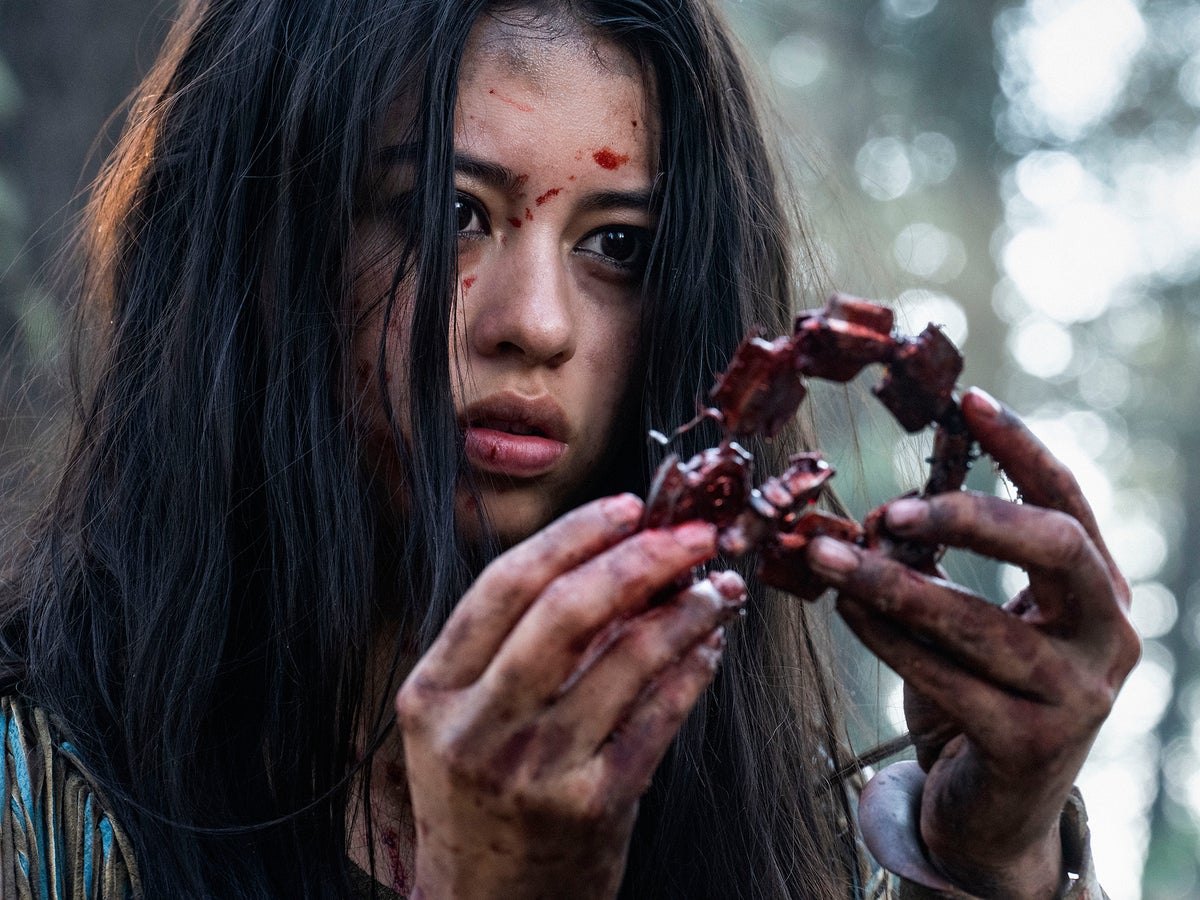
Dir: Dan Trachtenberg. Starring: Amber Midthunder, Dakota Beavers, Dane DiLiegro, Stormee Kipp, Michelle Thrush, Julian Black Antelope. 15, 99 minutes.
Prey didn’t need to be a Predator film. All those decades-spanning sequels, including Shane Black’s poorly received 2018 instalment, have lived in the shadow of that single, canonised image of a glistening Arnold Schwarzenegger dolled up in his war paint. None of them got close to replicating that muscle-bound greatness. But Prey succeeds by not even trying in the first place. Its thrills aren’t solely reliant on what’s already familiar to audiences. It isn’t powered by nostalgia – an exceedingly rare thing to see in mainstream cinema these days.
That’s not to say that, when our intergalactic murder-hulk does turn up, with its jaws like an origami fortune teller, the film doesn’t quake with childish glee. But this is, first and foremost, a brutal, pulse-quickening, emotionally rich story about an indigenous Comanche woman fighting for survival out in the American wilderness. It just so happens to be that, about halfway through, a trophy-hunting alien also turns up to join in on the game. In fact, the film’s director, Dan Trachtenberg, originally intended Prey to be marketed with no reference to its franchise connections, until the news was leaked online and the surprise was ruined. It’s shame – this could have been an all-timer of a narrative twist.
Set in the Comanche Nation, somewhere during the 1700s, Prey follows Naru (Amber Midthunder), a woman who, against the warnings of her elders, pushes to upturn patriarchal tradition and pass the initiation test that would solidify her place as a hunter. The Comanche men show little sympathy. When she suggests they set down bait for the mountain lion whose tracks they’ve been following, they mistake her shrewdness for weakness. But, when it comes to fending off a Predator, Naru’s home-ground advantage is pretty much all she’s got. Any hope for survival lies out there among the trees and the flowers and the earth.
And Trachtenberg’s film, working from a screenplay by Patrick Aison, makes the most of these pared-back surroundings. As its intricate hand-to-hand combat sequences play out, the crunch of bones seems to ricochet around the room you’re in – as does the satisfying thud of a throwing axe as it embeds itself into a tree trunk. The night scenes look surprisingly rich, illuminated by single torches or by the laser-quest-green glow of a Predator’s spilt blood.
There’s even a wicked sense of humour embedded in the chaos. A rabbit watches on, relieved, as a Predator de-spines a wolf. Elsewhere, a group of French-Canadian fur trappers, in a state of panic, try to reload their muskets as the alien lines up its laser sights. The film was made for and deserves to be seen on the big screen. But it’s incidentally become the victim of a corporate power struggle – Disney is dropping it straight onto streaming, as a prior contract would have required a theatrically released film to have initially gone onto HBO Max. Prey, arguably, has been let down by the fact Disney has too much confidence in the project.
Put aside the unfortunate consequences of the film’s own success, and there’s something deeply significant to be seen in an Indigenous-led narrative so proudly centered on a Hollywood project. There’s real care put into the details of Comanche life, as overseen by producer Jhane Myers – a Comanche and Blackfoot advocate and artist, who was able to take on a more hands-on role than the traditional “consultant” positions that allow projects to take performative credit while rarely lending a voice to the people it depicts. The film was shot in both English and Comanche, with both versions set to be available on Disney Plus.
Naru weaves rope made out of the fibres of tree bark, and is seen frantically trying to restring a snapped bow before a bear makes its attack. Midthunder imbues these scenes with a quiet determination. It’s a star-making performance. Naru’s a relatively subdued character, who communicates to us more through body language than she does words. Still, Midthunder has that kind of natural, undefinable gravitational force that draws the audience’s attention back to her even in moments of rest.
Prey’s setting makes logical sense – the mercilessness of the Predator, who hunts only for pride, is reflected in the actions of the white colonisers, who leave behind nothing but scorched forests and fields of dead buffalo. But the film simultaneously challenges the common assumption that Indigenous peoples like the Comanche were simply outmatched by the power of European gunfire, when the history of American expansion was really only achieved through persistent trickery and betrayal. The Comanche were actually very adept at fighting back against their oppressors. And the film, time and time again, sees Naru succeed specifically because those around her never treat her as a plausible threat. And so Trachtenberg’s film lands on a broader, more empowering message amid the alien mayhem – that the marginalised and the forgotten, in all forms, already have the tools they need to survive.
‘Prey’ is streaming on Disney Plus in the UK and Hulu in the US from 5 August







